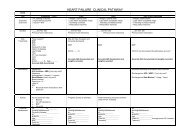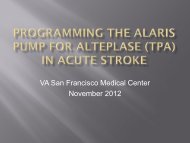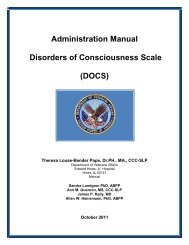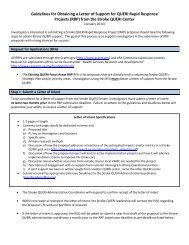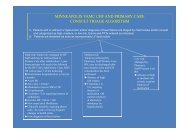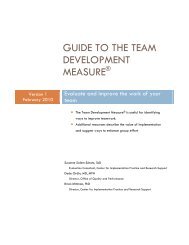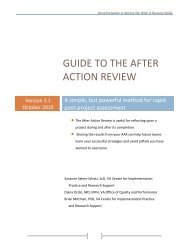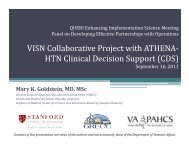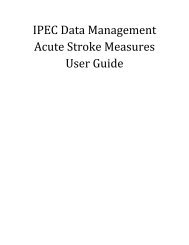The Veteran Supported Education Service Treatment Manual: VetSEd
The Veteran Supported Education Service Treatment Manual: VetSEd
The Veteran Supported Education Service Treatment Manual: VetSEd
You also want an ePaper? Increase the reach of your titles
YUMPU automatically turns print PDFs into web optimized ePapers that Google loves.
Appendix J<br />
206 | P a g e<br />
A “Home” for <strong>VetSEd</strong> - Options for VA<br />
In this section we explore the different service options in VA that could provide a<br />
―home‖ for supported education. <strong>The</strong> model is fairly self-contained and transportable,<br />
but also has complexities that are not often present in other programs. <strong>The</strong>se include the<br />
need to partner with colleges and perhaps even deliver the support on campus, as well as<br />
the need to link with <strong>Veteran</strong>s Benefits Administration (VBA) and Mental Health, just to<br />
name a few. As the VA leadership considers how to situate supported education within its<br />
array of services, there are many options, each presenting different strengths or<br />
opportunities. Some of these options are explored in this section.<br />
A. <strong>Supported</strong> <strong>Education</strong> as a <strong>Veteran</strong>s Health Administration (VHA)<br />
Clinical/Rehabilitative <strong>Service</strong><br />
<strong>Supported</strong> education was originally conceived and implemented within civilian<br />
rehabilitation medicine, more specifically psychiatric rehabilitation. Similar to its<br />
cousins, ‗supported employment‘ and ‗supported housing‘, there are many conceptual<br />
and practice related links between supported education and both clinical and<br />
rehabilitation services. Hence, all of these practices have arisen within the mental health<br />
arenas in both civilian and <strong>Veteran</strong> service systems. In the example of supported<br />
employment, a national roll-out of this service was situated within <strong>Veteran</strong>s Health<br />
Administration (VHA) clinical services (Resnick & Rosenheck, 2007) with necessary<br />
authorizing legislation. This was due in part because of the understanding that<br />
employment services have to be well integrated with clinical services in order to be<br />
successful (Becker & Drake, 2003). Another reason is that typically larger non-disability<br />
civilian services that address education, employment or housing, do not have the<br />
expertise or resources to address the unique dimensions of mental illness and the<br />
challenges this poses to successful community outcomes. Findings from our needs<br />
assessment also show that <strong>Veteran</strong>s prefer to have an integrated team of clinicians and<br />
supported education helpers.<br />
B. <strong>Supported</strong> <strong>Education</strong> and the <strong>Veteran</strong>s Benefits Administration (VBA)<br />
<strong>The</strong> findings of our needs assessment suggest the critical role of being able to access and<br />
use the Post 9/11 GI Bill in actualizing the education aspirations of <strong>Veteran</strong>s, and this is<br />
recognized by the <strong>Veteran</strong>s Benefits Administration (VBA). Recently the VBA has<br />
undertaken significant efforts to improve access to GI Bill information. <strong>The</strong> VBA too has<br />
recognized the need for outreach to <strong>Veteran</strong>s with disabilities on campuses and has



